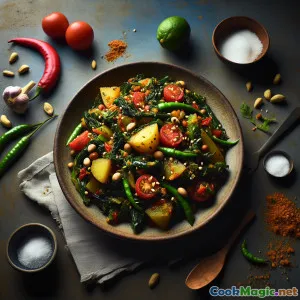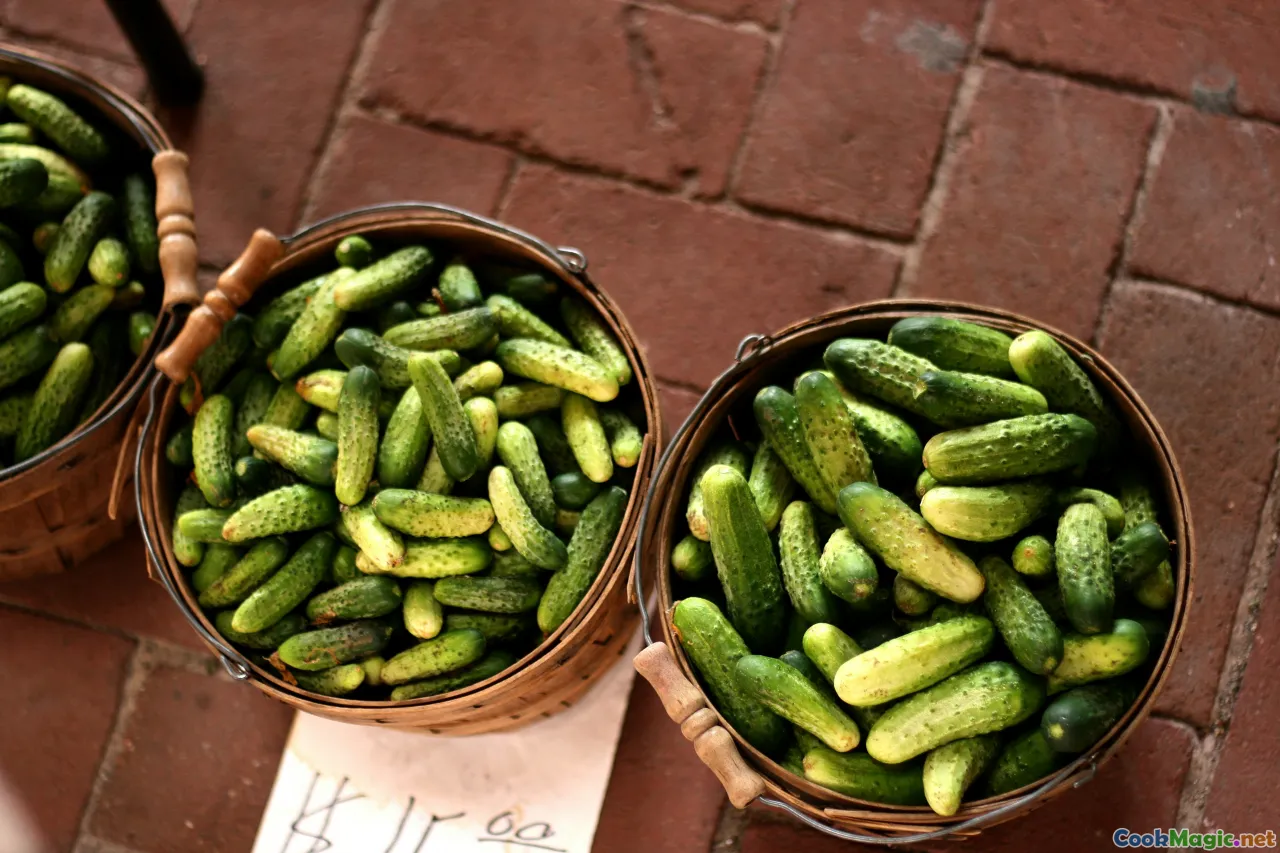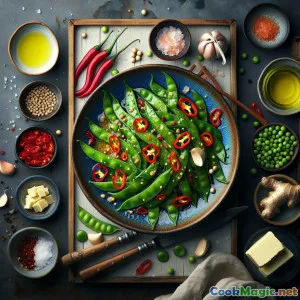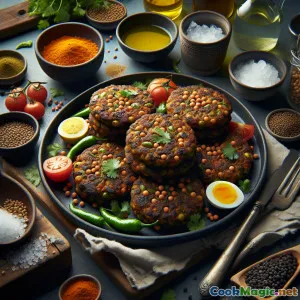
Gundruk Achaar Genuss: Pikant-säuerliches nepalesisches Pickle
(Gundruk Achaar Delight: Tangy Nepali Pickle)
(0 Bewertungen)0
316
Oktober 31, 2025
Problem melden
Zutaten
-
60 grams Getrockneter Gundruk (fermentiertes Blattgemüse)
(Soak to rehydrate; squeeze thoroughly)
-
500 ml kochendes Wasser (zum Einweichen)
(Enough to fully submerge gundruk)
-
2 medium Tomaten
(Roasted or charred for smoky depth)
-
1 medium Kartoffel, gekocht und gewürfelt
(Adds body; traditional in some regions)
-
3 tbsp Senföl
(Heat to smoking point, then cool slightly)
-
2 tbsp Geröstete Sesamsamen
(Lightly ground for creaminess)
-
2 pieces Grüne Chilischoten, fein gehackt
(Auf die Hitzevorlieben einstellen)
-
3 cloves Knoblauch (gehackt)
(Fresh for best aroma)
-
1 tbsp Ingwer (gerieben)
(Or 10g finely minced)
-
1 tsp Timur (nepalischer Sichuan-Pfeffer), gemahlen
(Substitute Szechuan peppercorns if needed)
-
0.5 tsp Bockhornkleesamen (methi)
(Bloom until deep brown, not burnt)
-
0.5 tsp Kurkuma-Pulver
(Quickly bloom in hot oil)
-
1 tsp Kreuzkümmelpulver
(Adds earthy warmth)
-
2 tbsp Zitronensaft
(Or use lime for sharper tang)
-
2 stalks Frühlingszwiebeln, fein geschnitten
(White and green parts)
-
2 tbsp Frischer Koriander (gehackt)
(Zum Garnieren und Frischeverleih)
-
1 tsp Salz
(Nach Geschmack anpassen)
-
0.5 tsp Zucker
(Balances acidity; optional)
-
2-3 tbsp Wasser (zur Anpassung der Konsistenz)
(Add only if mixture seems dry)
(Soak to rehydrate; squeeze thoroughly)
(Enough to fully submerge gundruk)
(Roasted or charred for smoky depth)
(Adds body; traditional in some regions)
(Heat to smoking point, then cool slightly)
(Lightly ground for creaminess)
(Auf die Hitzevorlieben einstellen)
(Fresh for best aroma)
(Or 10g finely minced)
(Substitute Szechuan peppercorns if needed)
(Bloom until deep brown, not burnt)
(Quickly bloom in hot oil)
(Adds earthy warmth)
(Or use lime for sharper tang)
(White and green parts)
(Zum Garnieren und Frischeverleih)
(Nach Geschmack anpassen)
(Balances acidity; optional)
(Add only if mixture seems dry)
Nährwerte
- Portionen: 6
- Portionsgröße: 2 EL (30 g)
- Calories: 120 kcal
- Carbohydrates: 0 g
- Protein: 3 g
- Fat: 9 g
- Fiber: 3 g
- Sugar: 2 g
- Sodium: 420 mg
- Cholesterol: 0 mg
- Calcium: 110 mg
- Iron: 2.1 mg
Anweisungen
-
1 - Rehydrate the gundruk:
Place dried gundruk in a bowl, pour boiling water to cover, and soak until pliable. Drain, rinse briefly, and squeeze firmly to remove excess liquid.
-
2 - Roast the tomatoes:
Char tomatoes over an open flame or in a dry skillet until blistered and softened. Peel loose skin, roughly chop, and mash lightly to a rustic pulp.
-
3 - Prepare optional potato:
If using, boil potato until just tender, then cool and dice into small cubes for better distribution in the achaar.
-
4 - Toast and grind sesame:
Lightly toast sesame seeds in a dry pan until fragrant. Cool, then pound or pulse to a coarse powder that will thicken the pickle.
-
5 - Temper spices in mustard oil:
Heat mustard oil until it reaches a light smoke. Add fenugreek seeds; when deep brown, switch off heat and quickly stir in turmeric. Let cool slightly to mellow.
-
6 - Make the aromatic paste:
Pound garlic, ginger, green chilies, cumin powder, and ground timur to a coarse paste. This paste drives the achaar’s heat and citrusy tingle.
-
7 - Combine Base Ingredients:
In a mixing bowl, combine squeezed gundruk, mashed roasted tomatoes, ground sesame, scallions, and optional potato. Season with salt and sugar if using.
-
8 - Finish with tang and temper:
Pour in the warm tempered oil, add lemon juice, and mix in the aromatic paste. If the mixture seems dry, splash in 2–3 tbsp water for cohesion.
-
9 - Rest, adjust, and serve:
Let the achaar sit 10 minutes to meld. Taste and adjust salt, lemon, or heat. Garnish with cilantro and serve as a side or condiment.
Place dried gundruk in a bowl, pour boiling water to cover, and soak until pliable. Drain, rinse briefly, and squeeze firmly to remove excess liquid.
Char tomatoes over an open flame or in a dry skillet until blistered and softened. Peel loose skin, roughly chop, and mash lightly to a rustic pulp.
If using, boil potato until just tender, then cool and dice into small cubes for better distribution in the achaar.
Lightly toast sesame seeds in a dry pan until fragrant. Cool, then pound or pulse to a coarse powder that will thicken the pickle.
Heat mustard oil until it reaches a light smoke. Add fenugreek seeds; when deep brown, switch off heat and quickly stir in turmeric. Let cool slightly to mellow.
Pound garlic, ginger, green chilies, cumin powder, and ground timur to a coarse paste. This paste drives the achaar’s heat and citrusy tingle.
In a mixing bowl, combine squeezed gundruk, mashed roasted tomatoes, ground sesame, scallions, and optional potato. Season with salt and sugar if using.
Pour in the warm tempered oil, add lemon juice, and mix in the aromatic paste. If the mixture seems dry, splash in 2–3 tbsp water for cohesion.
Let the achaar sit 10 minutes to meld. Taste and adjust salt, lemon, or heat. Garnish with cilantro and serve as a side or condiment.
Mehr über: Gundruk Achaar Genuss: Pikant-säuerliches nepalesisches Pickle
What Makes This Pickle Special
Gundruk Achaar Delight celebrates one of Nepal’s most cherished ingredients: gundruk—fermented, sun-dried leafy greens, often mustard or radish leaves. This humble ingredient carries thrilling depth: a tang that hints at lactic fermentation, a minerally savor from the greens themselves, and a satisfyingly chewy bite. When paired with roasted tomatoes, nutty sesame, and the signature bite of mustard oil, the result is a condiment that feels both rustic and remarkably complex.
Unlike shelf-stable bottled pickles, this achaar is a quick-mix preparation. The fermentation has already happened in the gundruk; your role is to amplify its character with heat, acid, spice, and texture. A short rest after mixing allows flavors to bloom, but it’s ready the day you make it, making it perfect for spontaneous feasts.
A Short History and Cultural Context
Gundruk is a cornerstone of Nepali foodways—an ingenious preservation method for seasonal leafy greens in the Himalayan climate. Families traditionally ferment greens in earthenware or tightly sealed containers before drying them under the mountain sun. The result keeps for months and becomes a pantry staple. Gundruk ko achaar often appears at home-style meals, festivals, and as a bright counterpoint to dal-bhat-tarkari (lentils, rice, and vegetables). The inclusion of timur (Zanthoxylum) is particularly Nepali: its citrusy, tingling aroma ties the achaar to the hills, as unmistakable as the mountain air.
Flavor Architecture and Technique
- Fermented tang: The gundruk’s lactic acidity sets the base.
- Fat and aroma: Mustard oil, heated to a light smoke, brings a peppery, wasabi-like high note that softens into a warm nuttiness once cooled and folded in.
- Earthy richness: Toasted sesame thickens the mixture and contributes a tahini-like roundness that marries the sour and spicy elements.
- Heat and buzz: Green chilies add straightforward heat, while ground timur contributes a citrus-tingly sensation distinct from black pepper.
- Gentle sweetness: Roasted tomatoes and a pinch of sugar (optional) round the edges of acidity.
Key tips for success:
- Squeeze the gundruk firmly after soaking. Excess water dilutes flavor and prevents the nutty sesame and mustard oil from clinging.
- Bloom spices properly. Fenugreek should turn deep brown (not black), and turmeric should be swirled in off-heat to avoid bitterness.
- Rest before serving. Even 10 minutes helps the sesame hydrate and the spices settle into harmony.
Serving Ideas
Gundruk Achaar is exceptionally versatile:
- Spoon over steamed rice with a drizzle of ghee for a minimalist but soul-satisfying bowl.
- Tuck into sel roti, paratha, or soft bread as a punchy spread.
- Serve alongside grilled meats or paneer—the tang cuts richness beautifully.
- Add to a grain bowl or quinoa salad for a bold, fermented accent.
Ingredient Notes and Substitutions
- Gundruk: If you can’t source it, try sauerkraut squeezed very dry and roughly chopped, then lightly pan-dried to temper sharpness. It won’t be authentic, but the vibe will be similar.
- Timur: Szechuan peppercorns are the closest substitute; grind fresh for the best citrusy bloom.
- Mustard oil: If unavailable, use a neutral oil plus 1 tsp mustard seeds bloomed until they pop; not identical, but effective.
- Sesame: White sesame works best; black sesame brings a deeper color and a slightly more robust flavor.
- Acid: Lemon or lime both work; Nepali kitchens may also use jhol (tomato-sour liquid) or fermented whey for complexity.
Texture and Balance
The ideal achaar is cohesive but not saucy, chunky yet spoonable. Sesame should lightly thicken, while the tomato pulp binds the gundruk. Optional potato brings comforting body, turning the condiment into a heartier side. If the mixture feels dry, a splash of water or a little more lemon helps it come together without making it soupy.
Make-Ahead and Storage
This achaar tastes best within 2–3 days, though it can keep refrigerated for up to a week in a clean, sealed jar. The flavors mellow and meld with time. For longer storage, increase acidity and salt slightly and always use sterilized jars and clean utensils.
Variations to Explore
- Sesame-forward: Add 1 more tbsp sesame and 1 tsp toasted sesame oil for a lush, tahini-like finish.
- Tomato-roasted: Char tomatoes deeply and add a pinch of smoked paprika for a campfire nuance.
- Heat lover’s: Stir in crushed dried red chilies or a spoon of timur-chili chutney.
- Herbaceous: Fold in chopped mint with cilantro for a cooler edge.
Personal Note
What makes Gundruk Achaar unforgettable is its sense of place. Every bite carries Himalayan ingenuity—fermentation as heritage, thrift as flavor, and warmth as hospitality. With a handful of pantry spices and a short tempering, you can cook a story that travels from sun-dried leaves to your table, bright as mountain morning and comforting as a home kitchen.























